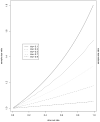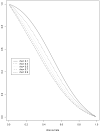A comparison of power analysis methods for evaluating effects of a predictor on slopes in longitudinal designs with missing data
- PMID: 22357710
- PMCID: PMC3913747
- DOI: 10.1177/0962280212437452
A comparison of power analysis methods for evaluating effects of a predictor on slopes in longitudinal designs with missing data
Abstract
In many longitudinal studies, evaluating the effect of a binary or continuous predictor variable on the rate of change of the outcome, i.e. slope, is often of primary interest. Sample size determination of these studies, however, is complicated by the expectation that missing data will occur due to missed visits, early drop out, and staggered entry. Despite the availability of methods for assessing power in longitudinal studies with missing data, the impact on power of the magnitude and distribution of missing data in the study population remain poorly understood. As a result, simple but erroneous alterations of the sample size formulae for complete/balanced data are commonly applied. These 'naive' approaches include the average sum of squares and average number of subjects methods. The goal of this article is to explore in greater detail the effect of missing data on study power and compare the performance of naive sample size methods to a correct maximum likelihood-based method using both mathematical and simulation-based approaches. Two different longitudinal aging studies are used to illustrate the methods.
Keywords: compound symmetry; intraclass correlation; linear mixed effects model; monotone missing; sample size.
© The Author(s) 2011.
Figures




Similar articles
-
Power and sample size calculations for evaluating mediation effects in longitudinal studies.Stat Methods Med Res. 2016 Apr;25(2):686-705. doi: 10.1177/0962280212465163. Epub 2012 Dec 6. Stat Methods Med Res. 2016. PMID: 23221975 Free PMC article.
-
Longitudinal data analysis with non-ignorable missing data.Stat Methods Med Res. 2016 Feb;25(1):205-20. doi: 10.1177/0962280212448721. Epub 2012 May 24. Stat Methods Med Res. 2016. PMID: 22637472 Free PMC article.
-
Pseudo-likelihood methods for longitudinal binary data with non-ignorable missing responses and covariates.Stat Med. 2006 Aug 30;25(16):2784-96. doi: 10.1002/sim.2435. Stat Med. 2006. PMID: 16345018
-
Subgroup analyses in randomised controlled trials: quantifying the risks of false-positives and false-negatives.Health Technol Assess. 2001;5(33):1-56. doi: 10.3310/hta5330. Health Technol Assess. 2001. PMID: 11701102 Review.
-
Making an unknown unknown a known unknown: Missing data in longitudinal neuroimaging studies.Dev Cogn Neurosci. 2018 Oct;33:83-98. doi: 10.1016/j.dcn.2017.10.001. Epub 2017 Oct 28. Dev Cogn Neurosci. 2018. PMID: 29129673 Free PMC article. Review.
Cited by
-
Power and sample size calculations for evaluating mediation effects in longitudinal studies.Stat Methods Med Res. 2016 Apr;25(2):686-705. doi: 10.1177/0962280212465163. Epub 2012 Dec 6. Stat Methods Med Res. 2016. PMID: 23221975 Free PMC article.
-
Power formulas for mixed effects models with random slope and intercept comparing rate of change across groups.Int J Biostat. 2021 Jan 18;18(1):173-182. doi: 10.1515/ijb-2020-0107. Int J Biostat. 2021. PMID: 33581000 Free PMC article.
-
Power and sample size analysis for longitudinal mixed models of health in populations exposed to environmental contaminants: a tutorial.BMC Med Res Methodol. 2023 Jan 12;23(1):12. doi: 10.1186/s12874-022-01819-y. BMC Med Res Methodol. 2023. PMID: 36635621 Free PMC article. Review.
-
Accounting for expected attrition in the planning of cluster randomized trials for assessing treatment effect heterogeneity.BMC Med Res Methodol. 2023 Apr 6;23(1):85. doi: 10.1186/s12874-023-01887-8. BMC Med Res Methodol. 2023. PMID: 37024809 Free PMC article.
-
Power and Sample Size for Fixed-Effects Inference in Reversible Linear Mixed Models.Am Stat. 2019;73(4):350-359. doi: 10.1080/00031305.2017.1415972. Epub 2018 Jun 4. Am Stat. 2019. PMID: 32042203 Free PMC article.
References
-
- Diggle PD, Heagerty P, Liang KY, Zeger SL. Analysis of longitudinal data. 2nd Oxford University Press; New York: 2002.
-
- Donner A, Klar N. Design and Analysis of Cluster Randomization Trials in Health Research. Arnold; London, England: 2000.
-
- Bloch DA. Sample size requirements and the cost of a randomized clinical trial with repeated measurements. Statistics in Medicine. 1986;5:663–667. - PubMed
-
- Rochon J. Sample size calculations for two-group repeated- measures experiments. Biometrics. 1991;47:1383–1398.
-
- Rochon J. Application of GEE procedures for sample size calculations in repeated measures experiments. Statistics in Medicine. 1998;17:1643–1658. - PubMed
Publication types
MeSH terms
Grants and funding
LinkOut - more resources
Full Text Sources
Research Materials

